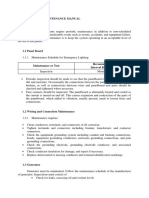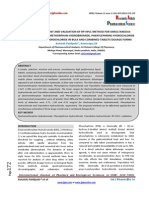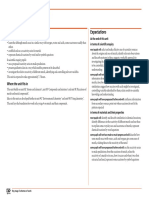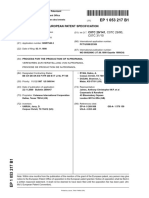Biopiracy Final
Biopiracy Final
Uploaded by
JonaLovinoCopyright:
Available Formats
Biopiracy Final
Biopiracy Final
Uploaded by
JonaLovinoOriginal Description:
Copyright
Available Formats
Share this document
Did you find this document useful?
Is this content inappropriate?
Copyright:
Available Formats
Biopiracy Final
Biopiracy Final
Uploaded by
JonaLovinoCopyright:
Available Formats
#57 Bio 1 X2 April 30, 2012
Biology News Daily
Assignment 2 Page 1 of 2
BIOPIRACY IN THE PHILIPPINES
by Jona Nichole Lovino
The Philippines is one of the most diverse countries in terms of flora and fauna. This has given the Filipinos an opportunity to explore the different uses of these resources, most of which are inherent to the country. Many indigenous communities have in fact health practices which have been proven to effective by modern medical societies.
Unfortunately, due to the lack of budget and resources, different countries are able to explore these first thereby seizing from us the opportunity to gain sizeable income. Instead, the country simply allows foreigners to secure patents to our medicinal plants and reap billions in profits, also known as biopiracy, and it is happening right under our nose. Common examples are the ylang-ylang plant and Milagrosa rice. The ylang-ylang plant, used in the manufacturing of perfumes, is now marketed by France; while, the Milagrosa rice, a high-quality and aromatic variety of rice, is now marketed by Thailand. Erithomycin, which was discovered by a Filipino scientist by isolating it from molds in soil of Iloilo, was developed by an American pharmaceutical company, sharing nothing to the Philippines but the namesake of the product, Ilosone. Another native plant biopirated is the banaba,
(Source: perfumeshrine.blogspot.com)
Above: Ylang-ylang plant
Inset: YSL Eau de Toilette
(Source: au.strawberrynet.com)
#57 Bio 1 X2 April 30, 2012
Biology News Daily
Assignment 2 Page 2 of 2
which is being marketed in Japan as a supplement to decrease blood sugar. And the list goes on. Mt. Pulog had been the interest of many foreign researchers. One time, 300 plant samples from the mountain were collected by unidentified Japanese; while, American researchers had discovered mountain dew (Taxus sumatran) and are now studying its anticancer properties. Palawan has also been a favourite hunting ground by biopirates; also, the marine life in Siquijor, Batanes, Pangasinan, Samar and Leyte are not spared. A controversial case of biopiracy in the country is the interest of US pharmaceutical companies on acquiring gene samples of Aetas, who are reportedly resistant to malaria and leprosy.
Intellectual Property Office, National Commission on Indigenous Peoples, Botany Division of the National Museum, Conservation International, and National Integrated Research Program on Medicinal Plants. Since the country is more accustomed to oral traditions in passing knowledge from generation to generation, the proposed digital library will protect the countrys medicinal plants, preventing biopiracy and at the same time, educating people on local medicinal plants. By posting the information in a public domain such as the proposed library, the Philippines will be given the right to it. Local medicinal plants include: ampalaya or bitter gourd, which is effective in treating diabetes; lagundi, for fever, asthma and headache; sambong, for gaseous stomachs, headache and fever; akapulco, for wound washing and itches; yerba buena, for cough, toothache, dizziness and arthritis. In the meantime, local authorities should not allow foreign investors to pirate the plant-based medicinal discoveries the countrys scientists have developed. It is also possible that NGOs might be helping these foreign pirates in acquiring samples. An instance was in 1992, when an NGO assisted in the collection of sea squirts, which are being studied for their anti-cancer properties. Low awareness is a big factor in these situations. It is the responsibility of these organizations to educate people on biopiracy.
Group of Aeta people (circa 1910)
(Source: liveinthephilippines.com)
This is a lesson the countrys herbal and drug experts learned the hard way. To prevent cases of biopiracy from occurring again, nine local groups are joining efforts to establish the Philippines own Traditional Knowledge Digital Library on health, a step originally taken by India who had also experienced biopiracy. This would document local medicinal plants used by traditional healers, locally called albularios. Experts will be coming from the Philippine Council for Health Research and Development of the Department of Science and Technology, Philippine Institute of Traditional and Alternative Health Care, University of the Philippines, Protected Areas and Wildlife Bureau,
Reference: http://simbahayan.tripod.com/B5-biopiracy05.html http://www.mb.com.ph/node/10155
You might also like
- Accounting Principles: Job Order CostingDocument65 pagesAccounting Principles: Job Order CostingShakib Ahmed Emon 0389No ratings yet
- ADSIA Logistics, Inc. Company ProfileDocument12 pagesADSIA Logistics, Inc. Company Profilelj_inosa100% (1)
- Lutensol To 8 Sds enDocument12 pagesLutensol To 8 Sds enGülşah Özkula Demirak50% (2)
- Pas 20 Government Grant: Conceptual Framework and Accounting StantardsDocument6 pagesPas 20 Government Grant: Conceptual Framework and Accounting StantardsMeg sharkNo ratings yet
- Jurisprudence Qualifying 2Document8 pagesJurisprudence Qualifying 2Aiza MinalabagNo ratings yet
- Attempt All The Questions. Choose The Most Appropriate Answer (Eg. A, B, C, D and E) in The Answer Sheet Provided at The Back of The PaperDocument6 pagesAttempt All The Questions. Choose The Most Appropriate Answer (Eg. A, B, C, D and E) in The Answer Sheet Provided at The Back of The PaperAmy Lubis100% (2)
- Laura Taylor Wholesale Distributor WorksheetDocument3 pagesLaura Taylor Wholesale Distributor WorksheetHope Trinity EnriquezNo ratings yet
- The Revised Corporation Code of The Philippines Republic Act No. 11232Document30 pagesThe Revised Corporation Code of The Philippines Republic Act No. 11232Poison IvyNo ratings yet
- Coblaw NotesDocument8 pagesCoblaw NotesIsabella Francia LafuenteNo ratings yet
- Test 1 Cost Behavior AnalysisDocument2 pagesTest 1 Cost Behavior Analysislester0% (1)
- Rizal Midterm (Prof Ramos)Document11 pagesRizal Midterm (Prof Ramos)Mitchie FaustinoNo ratings yet
- This Study Resource Was: I. PROBLEM SOLVING (10 Points: 2 Items X 5 Points)Document3 pagesThis Study Resource Was: I. PROBLEM SOLVING (10 Points: 2 Items X 5 Points)Dyana MeyNo ratings yet
- CABEIHM MGT 101 1 Human Resource Management 1Document5 pagesCABEIHM MGT 101 1 Human Resource Management 1Francine De veraNo ratings yet
- Toaz - Info 08 Agriculture With Ans Key PRDocument9 pagesToaz - Info 08 Agriculture With Ans Key PRRica BarbozaNo ratings yet
- DocumenthhDocument4 pagesDocumenthhKurt Del RosarioNo ratings yet
- CHAPTER 4 - Job Order Costing: Learning ObjectivesDocument3 pagesCHAPTER 4 - Job Order Costing: Learning Objectivesyes yesnoNo ratings yet
- Financial Market StructureDocument17 pagesFinancial Market StructureVishnu Pathak100% (1)
- LUCAS FME111 InsuranceRiskMngmtDocument6 pagesLUCAS FME111 InsuranceRiskMngmtJohnVerjoGeronimoNo ratings yet
- GROUP 3 - Maynilad Water Services IncDocument23 pagesGROUP 3 - Maynilad Water Services Incgabrieltb2134No ratings yet
- Medical TraditionsDocument10 pagesMedical TraditionsAngelle Loise EstanteNo ratings yet
- Intermediate Accounting - Property, Plant, and EquipmentDocument8 pagesIntermediate Accounting - Property, Plant, and Equipment22100629No ratings yet
- M2 Historical Criticism Learning Activity 3Document1 pageM2 Historical Criticism Learning Activity 3Charise PerezNo ratings yet
- Ia2 Current LiabilitiesDocument26 pagesIa2 Current LiabilitiesNicole Ann MercurioNo ratings yet
- CHAPTER 1 The Social Dimension of Science Technology Technological Terminism and Construction of TechnologyDocument1 pageCHAPTER 1 The Social Dimension of Science Technology Technological Terminism and Construction of TechnologyMarcoNo ratings yet
- Intangible AssetsDocument4 pagesIntangible AssetsDianna DayawonNo ratings yet
- Module 3 - ContractsDocument21 pagesModule 3 - ContractsKoji Brian ReyesNo ratings yet
- Washington Sycip Reaction Paper (Santos - 3A7)Document3 pagesWashington Sycip Reaction Paper (Santos - 3A7)The Brain Dump PHNo ratings yet
- Module 6 - Ppe RevalutionDocument4 pagesModule 6 - Ppe RevalutionARISNo ratings yet
- COOPERATIVES NotesDocument6 pagesCOOPERATIVES NotesKate LotaNo ratings yet
- 20 - Wasting AssetsDocument5 pages20 - Wasting AssetsYudna YuNo ratings yet
- M4 Learning Activity 2 PDFDocument2 pagesM4 Learning Activity 2 PDFWhat do you mean mhNo ratings yet
- Intacc 1-Investment in Debt SecuritiesDocument5 pagesIntacc 1-Investment in Debt SecuritiesShekainah BNo ratings yet
- 5study GuideCONTRACTS Chapter 5Document4 pages5study GuideCONTRACTS Chapter 5Al Cheeno AnonuevoNo ratings yet
- Stay Even Chapter 3 Managerial EconomicsDocument2 pagesStay Even Chapter 3 Managerial EconomicsOne DozenNo ratings yet
- 07 Task Performance 1Document2 pages07 Task Performance 1Emperor SavageNo ratings yet
- Confras Transes Module 1 and 2Document16 pagesConfras Transes Module 1 and 2Cielo MINDANAONo ratings yet
- ACCO 20063 - Conceptual Framework and Accounting StandardsDocument21 pagesACCO 20063 - Conceptual Framework and Accounting StandardsSarmiento Rona A.No ratings yet
- Assignment Nos. 10 OligopolyDocument2 pagesAssignment Nos. 10 OligopolyCaballero, Charlotte MichaellaNo ratings yet
- URC Fundamental Analysis 2021 - 2022Document42 pagesURC Fundamental Analysis 2021 - 2022Arabelle BadiangNo ratings yet
- Prequalifying Exam Level 2 3 Set B FSUU AccountingDocument9 pagesPrequalifying Exam Level 2 3 Set B FSUU AccountingRobert CastilloNo ratings yet
- FAR.3515 Cash and Cash EquivalentsDocument4 pagesFAR.3515 Cash and Cash Equivalentsmarlou mNo ratings yet
- Cebu Air, Inc. Parent Company FS - December 31, 2023Document112 pagesCebu Air, Inc. Parent Company FS - December 31, 2023jason6686pNo ratings yet
- Toa Quizzer 1: Multiple ChoiceDocument18 pagesToa Quizzer 1: Multiple ChoiceRukia KuchikiNo ratings yet
- Managerial Accounting Absorption and Variable Costing 081712Document14 pagesManagerial Accounting Absorption and Variable Costing 081712Mary Ann Jacolbe BaguioNo ratings yet
- Quiz 1 - IntroDocument5 pagesQuiz 1 - Introcoleenmaem.04No ratings yet
- Article 1270 To Article 1290Document10 pagesArticle 1270 To Article 1290ronniejrumandapNo ratings yet
- Org Behavior CH 4Document78 pagesOrg Behavior CH 4kaskadian75% (8)
- HW1 LawsDocument8 pagesHW1 LawsJocelyn Monceller100% (1)
- Enron ScandalDocument2 pagesEnron ScandalKoko LaineNo ratings yet
- Altoveros, Akhiel Jeus S. - 3-AIS - MS301 - AT1 - PrelimDocument3 pagesAltoveros, Akhiel Jeus S. - 3-AIS - MS301 - AT1 - PrelimAkhiel Jeus AltoverosNo ratings yet
- 03TaskPerformance2 FMDocument4 pages03TaskPerformance2 FMAilaJeanine0% (1)
- Valencia Chap 5 Estate TaxDocument11 pagesValencia Chap 5 Estate TaxCha DumpyNo ratings yet
- Ethics 2231Document2 pagesEthics 2231Alrom DonesNo ratings yet
- 6809 Accounts ReceivableDocument2 pages6809 Accounts ReceivableEsse Valdez0% (1)
- Our Lady of Fatima UniversityDocument3 pagesOur Lady of Fatima UniversityJasmine Nouvel Soriaga CruzNo ratings yet
- Ideas That Change The WorldDocument46 pagesIdeas That Change The WorldErin FontanillaNo ratings yet
- MAS 8 FS Analysis AnswersDocument15 pagesMAS 8 FS Analysis AnswersKatherine Cabading InocandoNo ratings yet
- The Corporation Rhetorical AnalysisDocument6 pagesThe Corporation Rhetorical Analysisapi-272722786No ratings yet
- Farparcor 2 Chapter 1 Exercises Problem AnswersDocument10 pagesFarparcor 2 Chapter 1 Exercises Problem AnswersWillnie Shane LabaroNo ratings yet
- Biopiracy PresentationDocument6 pagesBiopiracy PresentationChin CentsNo ratings yet
- Biopiracy KDocument19 pagesBiopiracy KJohn MikolajcikNo ratings yet
- Insights Into Insecticide-Resistance Mechanisms in Invasive SpeciesDocument18 pagesInsights Into Insecticide-Resistance Mechanisms in Invasive SpeciesNg Kin HoongNo ratings yet
- Genbio2 Module 7.8 Digestive SystemDocument8 pagesGenbio2 Module 7.8 Digestive SystemBRIANNE ANGELA PASIANo ratings yet
- Vaccum Pan Circulator PDFDocument10 pagesVaccum Pan Circulator PDFMiguel MurilloNo ratings yet
- For Review OnlyDocument23 pagesFor Review OnlyClaire Tejada-montefalcoNo ratings yet
- Effect of Metal Coupling O Rusting of IronDocument11 pagesEffect of Metal Coupling O Rusting of IronSourabh Roshan RamtekeNo ratings yet
- Spirit of MercuryDocument5 pagesSpirit of MercurytravellerfellowNo ratings yet
- ROV Tools RequirementDocument8 pagesROV Tools RequirementKufre2No ratings yet
- Administering Medications by Intravenous Bolus or Push Through An Intravenous InfusionDocument3 pagesAdministering Medications by Intravenous Bolus or Push Through An Intravenous Infusionchalinsammy1No ratings yet
- PENTOSIN Safety Data Sheet ENDocument9 pagesPENTOSIN Safety Data Sheet ENTop AutoNo ratings yet
- Electrical Maintenance Manual 1. GeneralDocument2 pagesElectrical Maintenance Manual 1. GeneralPJ Reyes RosalNo ratings yet
- Assignment Process Flow Diagram and The Heat Exchangers Used in Polyethene ProductionDocument7 pagesAssignment Process Flow Diagram and The Heat Exchangers Used in Polyethene ProductionChamuditha BenaragamaNo ratings yet
- Igneous Rock Clan2Document23 pagesIgneous Rock Clan2Galang VirgiawanNo ratings yet
- Industrial Project Report Magazine For EntrepreneurDocument17 pagesIndustrial Project Report Magazine For EntrepreneureiribooksNo ratings yet
- Medical Device Standards and Implant StandardsDocument13 pagesMedical Device Standards and Implant StandardsAnil Kumar40% (5)
- A Sustainability Guide For Everyday FolkDocument16 pagesA Sustainability Guide For Everyday FolkwhsprzNo ratings yet
- Kotaiah - Paidipala, Kamarapu - SK: Available Online ThroughDocument8 pagesKotaiah - Paidipala, Kamarapu - SK: Available Online ThroughLandyyun Rahmawan SNo ratings yet
- Oil Data ComparisonsDocument45 pagesOil Data ComparisonsKevins Small Engine and Tractor ServiceNo ratings yet
- Pac Polymers (All Grades)Document4 pagesPac Polymers (All Grades)adrianNo ratings yet
- History of The Glass PDFDocument7 pagesHistory of The Glass PDFAntonValyNo ratings yet
- About The Unit: Unit 9F Patterns of ReactivityDocument8 pagesAbout The Unit: Unit 9F Patterns of Reactivitysanchos86No ratings yet
- List of Approved Materials Civil Works: Sr. No. Materials MakeDocument4 pagesList of Approved Materials Civil Works: Sr. No. Materials MakeRavi Sankar GarimellaNo ratings yet
- Iso 643 2019Document11 pagesIso 643 2019Navid MohammadiNo ratings yet
- Hydrogenation of PropionaldehydeDocument8 pagesHydrogenation of PropionaldehydeNur Zafirah Binti Mohamad FoziNo ratings yet
- Understanding Flexible PU Prices IncreaseDocument38 pagesUnderstanding Flexible PU Prices IncreasedangcongsanNo ratings yet
- Hydro-Pulping: A Pulper - A Large, Agitated Water Tank - Is Used To Separate PaperDocument2 pagesHydro-Pulping: A Pulper - A Large, Agitated Water Tank - Is Used To Separate PaperMBA103003No ratings yet
- 5 Types of ReactionsDocument18 pages5 Types of ReactionsMohammad AlHamdany100% (1)
- Valvoline ATF Dexron III MerconDocument10 pagesValvoline ATF Dexron III MerconNyamdavaa KhatanbaatarNo ratings yet
- Macadamia-Plant-Protection-Guide 2018-2019Document115 pagesMacadamia-Plant-Protection-Guide 2018-2019DIEGO FERNANDO CASAS LOPEZNo ratings yet
- Gravimetric AnalysisDocument9 pagesGravimetric AnalysisKim0% (1)

























































































